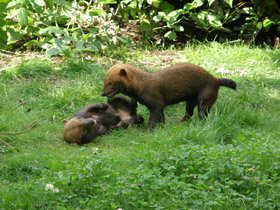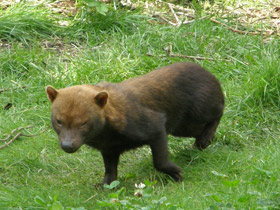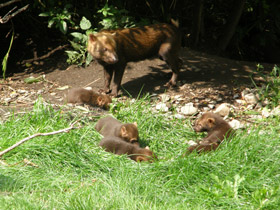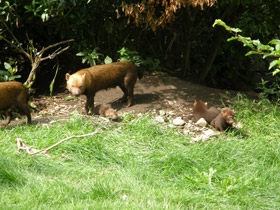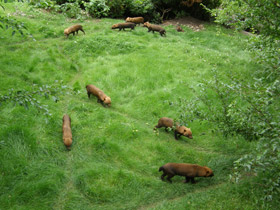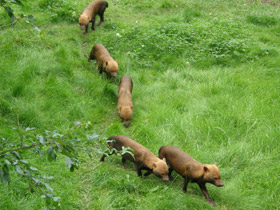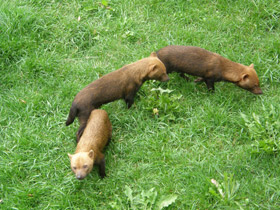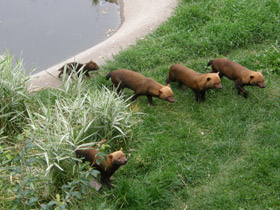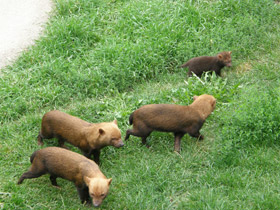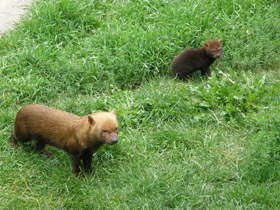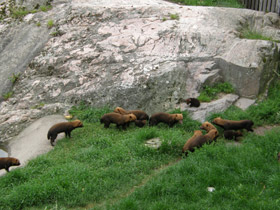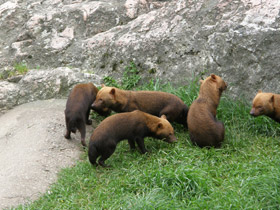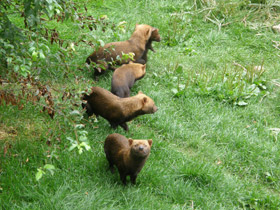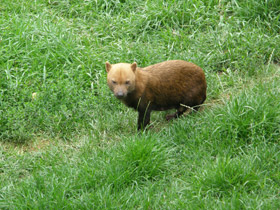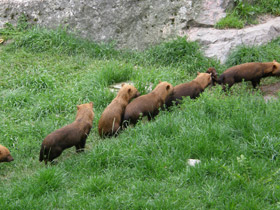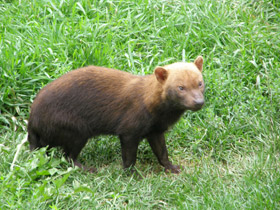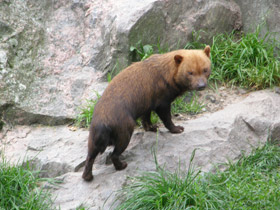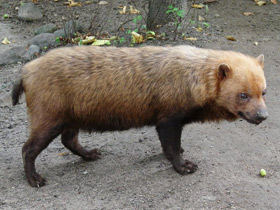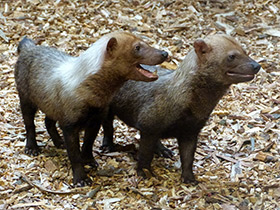The bush dog(Speothos venaticus)
Bush dog видео
The bush dog (Speothos venaticus) is a canine found in Central and South America. In spite of its extensive range, it is very rare in most areas except in Suriname, Guyana and Peru; it was first described by Peter Wilhelm Lund from fossils in Brazilian caves and was believed to be extinct.
The bush dog is the only living species in the genus Speothos, and genetic evidence suggests that its closest living relative is the maned wolf of central South America or the African wild dog. The species is listed as Near Threatened by the IUCN.
In Brazil, it is called cachorro-vinagre ('vinegar dog') and cachorro-do-mato ('bush dog'). In Spanish-speaking countries, it is called perro vinagre ('vinegar dog'), zorro vinagre ('vinegar fox'), perro de agua ('water dog'), and perro de monte ('mountain dog').
Appearance
These animals are not large, with an adult height at withers of 30 cm and a body length of 75 cm and a weight of 7 kg. But they have a rather muscular build, despite their elongated torso. It has relatively short limbs, a large head and a short, rounded muzzle with very small ears and rather large eyes. The tail of Speothos venaticus is not fluffy, but has long hair; its coat is smooth and stiff, tinged with reddish brown, and some individuals have a small white patch on the throat. These exceptional foxes are well adapted to life in the thickets of riverbanks, and can easily pass through their thickets.
Distribution and habitat
Bush dogs are found from Costa Rica in Central America and throughout much of South America east of the Andes, as far south as central Bolivia, Paraguay and southern Brazil. They mainly inhabit lowland forests up to 1,900 metres (6,200 feet) in altitude, wet savannahs and other habitats near rivers, but can also be found in drier cerrados and open grasslands. The historical range of this species may have extended as far north as Costa Rica, where it can still be found in suitable habitats. New and repeated sightings of bush dog groups have been recorded in east-central (Barbilla National Park) and southeastern (La Amistad International Park) Costa Rica, and in a considerable part of the Talamanca Mountains as far north-northwest as 120 km (75 mi) and at elevations up to 2,119 m (6,952 ft). At the Manzanilla site on the east coast of Trinidad, very recent fossils have been found dating to between 300 and 900 AD (the Late Ceramic Age).
There are three recognised subspecies:
- The South American bush dog (Speothos venaticus venaticus), whose range includes southern Colombia and Venezuela, the Guianas, most of Brazil, eastern Ecuador and Peru, Bolivia and northern Paraguay.
- The Panamanian bush dog (Speothos venaticus panamensis), whose range includes Panama, northern Colombia and Venezuela and western Ecuador.
- The southern bush dog (Speothos venaticus wingei), with a range that includes southern Brazil and Paraguay, as well as extreme northeastern Argentina. The first camera trap photos of this species in Argentina were obtained in April 2016 at the Reserva Ecológica Privada Selva Paranaense Don Otto, located in the Eldorado Department of Misiones province, Argentina.
Behaviour
Bush dogs are carnivores and hunt during the day. Typical prey are pacas, agoutis, acouchis and capybaras, all large rodents. Dogs can take much larger prey, such as peccaries and rheas, and a 250 kg (550 lb) tapir has even been recorded being hunted by a pack of six dogs, which followed the animal and chewed at its legs until it was down. When hunting bales, part of the pack chases them on land and another part waits for them in the water, where they often retreat.
Bush dogs seem to be the most gregarious of the South American canid species. They use hollow logs and cavities like armadillo burrows for shelter. Herds consist of a single pair and their immediate relatives, and their range varies between 3.8 and 10 square kilometres. Only the adult pair breeds, while the other members of the herd are subordinate and help raise and guard the cubs. Pack mates keep in contact with frequent whining, perhaps because visibility is poor in the undergrowth where they often hunt. When eating large prey, the parents stand at either end of the animal, making it easier for the cubs to gut it.
Lifestyle and reproduction
Speothos venaticus is a predator and its diet consists mainly of large South American rodents, acushi, aguti and paca, as well as capybaras and nandu. Larger and more numerous animals are often attacked by Speothos venaticus in herds. They can swim and dive well and sometimes catch capybaras in the water. They chew meat without swallowing it, which is functionally related to the smaller number of molar teeth and the poor development of the remaining teeth - Speothos venaticus has the smallest number of teeth of all representatives of the canine family, 38-40.
Very little is known about the life of these animals in the wild, for example, according to some sources they hunt at night, others say they lead a diurnal life and sleep at night in a dug hole or among the roots of trees. Speothos venaticus is very social and always keeps packs of 10-12 animals. As with wolves, the dominant female dominates the other females to prevent them from breeding; she herself may give birth twice a year. After a gestation period of two months, the female gives birth to 4 to 6 pups in the den. She feeds her pups with milk until they are 8 weeks old, and at one year of age the young dogs reach sexual maturity. The males provide food for the bitches during this time. Bush dogs are not noted for their vocal abilities: they produce a high-pitched, bark-like sound with which they communicate with each other in dense forests or among bushes.
Conservation status
Speothos venaticus is a very rare animal, until recently thought to be extinct and known only from fossils found in Brazil. However, scientists have not only managed to find them alive, but also to study their behaviour, breeding and feeding patterns and even to breed them in captivity. Speothos venaticus is listed in the International Red Data Book as a vulnerable species, so hunting is strictly forbidden. Native Americans capture and domesticate them and keep them as pets.

















